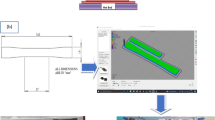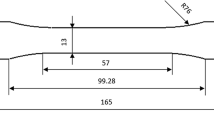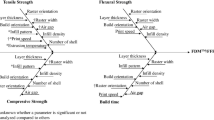Abstract
This study investigates the effects of four variables during fused filament fabrication of organic biocompatible composite material, PLA with coconut flour, at the ultimate tensile strength (UTS), and elasticity module (E) of the printed parts. The parameter optimization uses Taguchi L18 design and regression models. The examined deposition variables are the layer thickness, the nozzle temperature, the raster deposition angle, and filament printing speed. The effects of the above variables on the strength of the parts are essential to enhance the mechanical response of the printed parts. The experimental outcomes are investigated using the ANOM and ANOVA and modeled utilizing linear regression models. In addition, an independent experiment was repeated three times at optimum parameters’ levels to evaluate the methodology, giving predictions errors less than 3%. The observed results showed that the raster deposition angle dominates among the other variables in the studied experimental area.








Similar content being viewed by others
Availability of data and material (data transparency)
All data generated or analyzed during this study are included in this published article.
References
Wong KV, Hernandez A (2012) A Review of Additive Manufacturing. ISRN Mech Eng 2012:1–10. https://doi.org/10.5402/2012/208760
Oliveira JP, Santos TG, Miranda RM (2020) Revisiting fundamental welding concepts to improve additive manufacturing: From theory to practice. Prog Mater Sci 107:100590. https://doi.org/10.1016/j.pmatsci.2019.100590
Oliveira JP, LaLonde AD, Ma J (2020) Processing parameters in laser powder bed fusion metal additive manufacturing. Mater Des 193:108762. https://doi.org/10.1016/j.matdes.2020.108762
Pringle AM, Rudnicki M, Pearce JM (2018) Wood Furniture Waste–Based Recycled 3-D Printing Filament. For Prod J 68:86–95. https://doi.org/10.13073/FPJ-D-17-00042
Yap YL, Yeong WY (2014) Additive manufacture of fashion and jewellery products: a mini review. Virtual Phys Prototyp 9:195–201. https://doi.org/10.1080/17452759.2014.938993
Goh GD, Yap YL, Tan HKJ et al (2020) Process–structure–properties in polymer additive manufacturing via material extrusion: A review. Crit Rev Solid State Mater Sci 45:113–133. https://doi.org/10.1080/10408436.2018.1549977
Aida HJ, Nadlene R, Mastura MT et al (2021) Natural fibre filament for Fused Deposition Modelling (FDM): a review. Int J Sustain Eng. https://doi.org/10.1080/19397038.2021.1962426
Vidakis N, Petousis M, Savvakis K et al (2019) A comprehensive investigation of the mechanical behavior and the dielectrics of pure polylactic acid (PLA) and PLA with graphene (GnP) in fused deposition modeling (FDM). Int J Plast Technol 23:195–206. https://doi.org/10.1007/s12588-019-09248-1
Vidakis N, Petousis M, Velidakis E et al (2020) Three-dimensional printed antimicrobial objects of polylactic acid (PLA)-Silver nanoparticle nanocomposite filaments produced by an in-situ reduction reactive melt mixing process. Biomimetics 5:42. https://doi.org/10.3390/biomimetics5030042
Chaidas D, Kechagias JD (2021) An investigation of PLA/W parts quality fabricated by FFF. Mater Manuf Process. https://doi.org/10.1080/10426914.2021.1944193
Vidakis N, Petousis M, Maniadi A et al (2020) Sustainable additive manufacturing: mechanical response of acrylonitrile-butadiene-styrene over multiple recycling processes. Sustainability 12:3568. https://doi.org/10.3390/su12093568
Faludi G, Dora G, Renner K et al (2013) Improving interfacial adhesion in pla/wood biocomposites. Compos Sci Technol 89:77–82. https://doi.org/10.1016/j.compscitech.2013.09.009
Ćwikła G, Grabowik C, Kalinowski K et al (2017) The influence of printing parameters on selected mechanical properties of FDM/FFF 3D-printed parts. IOP Conf Ser: Mater Sci Eng 227:012033. https://doi.org/10.1088/1757-899X/227/1/012033
Mohan N, Senthil P, Vinodh S, Jayanth N (2017) A review on composite materials and process parameters optimisation for the fused deposition modelling process. Virtual Phys Prototyp 12:47–59. https://doi.org/10.1080/17452759.2016.1274490
Bikas H, Stavropoulos P, Chryssolouris G (2016) Additive manufacturing methods and modelling approaches: a critical review. Int J Adv Manuf Technol 83:389–405. https://doi.org/10.1007/s00170-015-7576-2
Vidakis N, Petousis M, Velidakis E et al (2020) On the strain rate sensitivity of fused filament fabrication (FFF) processed PLA, ABS, PETG, PA6, and PP thermoplastic polymers. Polymers 12:2924. https://doi.org/10.3390/polym12122924
Durgun I, Ertan R (2014) Experimental investigation of FDM process for improvement of mechanical properties and production cost. Rapid Prototyp J 20:228–235. https://doi.org/10.1108/RPJ-10-2012-0091
Kechagias JD, Vidakis N, Petousis M (2021) Parameter effects and process modeling of FFF-TPU mechanical response. Mater Manuf Process. https://doi.org/10.1080/10426914.2021.2001523
Kain S, Ecker JV, Haider A et al (2020) Effects of the infill pattern on mechanical properties of fused layer modeling (FLM) 3D printed wood/polylactic acid (PLA) composites. Eur J Wood Wood Prod 78:65–74. https://doi.org/10.1007/s00107-019-01473-0
Fountas NA, Kechagias JD, Manolakos DE, Vaxevanidis NM (2020) Single and multi-objective optimization of FDM-based additive manufacturing using metaheuristic algorithms. Procedia Manuf 51:740–747. https://doi.org/10.1016/j.promfg.2020.10.104
Fountas NA, Kitsakis K, Aslani K-E et al (2021) An experimental investigation of surface roughness in 3D-printed PLA items using design of experiments. Proc Inst Mech Eng J: J Eng Tribol. https://doi.org/10.1177/13506501211059306
Kechagias J, Kitsakis K, Zacharias A et al (2021) Direct 3D Printing of a hand splint using Reverse Engineering. IOP Conf Ser: Mater Sci Eng 1037:012019. https://doi.org/10.1088/1757-899X/1037/1/012019
Chaidas D, Kitsakis K, Kechagias J, Maropoulos S (2016) The impact of temperature changing on surface roughness of FFF process. IOP Conf Ser: Mater Sci Eng 161:012033. https://doi.org/10.1088/1757-899X/161/1/012033
Aslani K-E, Chaidas D, Kechagias J et al (2020) Quality performance evaluation of thin walled PLA 3D printed parts using the taguchi method and grey relational analysis. J Manuf Mater Process. https://doi.org/10.3390/jmmp4020047
Afrose MF, Masood SH, Iovenitti P et al (2016) Effects of part build orientations on fatigue behaviour of FDM-processed PLA material. Prog Addit Manuf 1:21–28. https://doi.org/10.1007/s40964-015-0002-3
Vidakis N, Vairis A, Petousis M et al (2016) Fused deposition modelling parts tensile strength characterisation. Academic J Manuf Eng 14
Gurrala PK, Regalla SP (2014) Multi-objective optimisation of strength and volumetric shrinkage of FDM parts. Virtual Phys Prototyp 9:127–138. https://doi.org/10.1080/17452759.2014.898851
Srivastava M, Rathee S (2018) Optimisation of FDM process parameters by Taguchi method for imparting customised properties to components. Virtual Phys Prototyp 13:203–210. https://doi.org/10.1080/17452759.2018.1440722
Coogan TJ, Kazmer DO (2017) Bond and part strength in fused deposition modeling. Rapid Prototyp J 23:414–422. https://doi.org/10.1108/RPJ-03-2016-0050
Vanaei HR, Shirinbayan M, Deligant M et al (2021) In-Process Monitoring of Temperature Evolution during Fused Filament Fabrication: A Journey from Numerical to Experimental Approaches. Thermo 1:332–360. https://doi.org/10.3390/thermo1030021
Chen K, Yu L, Cui Y et al (2021) Optimization of printing parameters of 3D-printed continuous glass fiber reinforced polylactic acid composites. Thin-Walled Struct 164:107717. https://doi.org/10.1016/j.tws.2021.107717
Motas JG, Gorji NE, Nedelcu D et al (2021) XPS, SEM, DSC and Nanoindentation Characterization of Silver Nanoparticle-Coated Biopolymer Pellets. Appl Sci 11:7706. https://doi.org/10.3390/app11167706
Bhagia S, Lowden RR, Erdman D et al (2020) Tensile properties of 3D-printed wood-filled PLA materials using poplar trees. Appl Mater Today 21:100832. https://doi.org/10.1016/j.apmt.2020.100832
Bulanda K, Oleksy M, Oliwa R et al (2020) Biodegradable polymer composites based on polylactide used in selected 3D technologies. Polimery 65:557–562. https://doi.org/10.14314/polimery.2020.7.8
Chansoda K, Suwanjamrat C, Chookaew W (2020) Study on processability and mechanical properties of parawood-powder filled PLA for 3D printing material. IOP Conf Ser: Mater Sci Eng 773:012053. https://doi.org/10.1088/1757-899X/773/1/012053
Yang T-C, Yeh C-H (2020) Morphology and Mechanical Properties of 3D Printed Wood Fiber/Polylactic Acid Composite Parts Using Fused Deposition Modeling (FDM): The Effects of Printing Speed. Polymers 12:1334. https://doi.org/10.3390/polym12061334
Ayrilmis N, Kariz M, Kwon JH, Kitek Kuzman M (2019) Effect of printing layer thickness on water absorption and mechanical properties of 3D-printed wood/PLA composite materials. Int J Adv Manuf Technol 102:2195–2200. https://doi.org/10.1007/s00170-019-03299-9
Zandi MD, Jerez-Mesa R, Lluma-Fuentes J et al (2020) Experimental analysis of manufacturing parameters’ effect on the flexural properties of wood-PLA composite parts built through FFF. Int J Adv Manuf Technol 106:3985–3998. https://doi.org/10.1007/s00170-019-04907-4
Guessasma S, Belhabib S, Nouri H (2019) Microstructure and mechanical performance of 3D printed wood-PLA/PHA using fused deposition modelling: Effect of printing temperature. Polymers 11:1778. https://doi.org/10.3390/polym11111778
Tsiolikas A, Mikrou T, Vakouftsi F et al (2019) Robust design application for optimizing ABS fused filament fabrication process: A case study. IOP Conf Ser: Mater Sci Eng 564:012021. https://doi.org/10.1088/1757-899X/564/1/012021
Kechagias J, Petropoulos G, Vaxevanidis N (2012) Application of Taguchi design for quality characterization of abrasive water jet machining of TRIP sheet steels. Int J Adv Manuf Technol 62:635–643. https://doi.org/10.1007/s00170-011-3815-3
Zhang JZ, Chen JC, Kirby ED (2007) Surface roughness optimization in an end-milling operation using the Taguchi design method. J Mater Process Technol 184:233–239. https://doi.org/10.1016/j.jmatprotec.2006.11.029
Kechagias JD, Aslani K-E, Fountas NA et al (2020) A comparative investigation of Taguchi and full factorial design for machinability prediction in turning of a titanium alloy. Measurement 151:107213. https://doi.org/10.1016/j.measurement.2019.107213
Phadke MS (1989) Quality engineering using robust design. Prentice Hall, Englewood Cliffs, New Jersey, p 07632
Gopinath C, Lakshmanan P, Palani S (2021) Fiber laser microcutting on duplex steel: parameter optimization by TOPSIS. Mater Manuf Process. https://doi.org/10.1080/10426914.2021.1981939
Saxena P, Stavropoulos P, Kechagias J, Salonitis K (2020) Sustainability assessment for manufacturing operations. Energies. https://doi.org/10.3390/en13112730
Harris M, Potgieter J, Archer R, Arif KM (2019) In-process thermal treatment of polylactic acid in fused deposition modelling. Mater Manuf Process 34:701–713. https://doi.org/10.1080/10426914.2019.1566611
Tamburrino F, Graziosi S, Bordegoni M (2019) The influence of slicing parameters on the multi-material adhesion mechanisms of FDM printed parts: an exploratory study. Virtual Phys Prototyp 14:316–332. https://doi.org/10.1080/17452759.2019.1607758
Hashemi Sanatgar R, Campagne C, Nierstrasz V (2017) Investigation of the adhesion properties of direct 3D printing of polymers and nanocomposites on textiles: Effect of FDM printing process parameters. Appl Surf Sci 403:551–563. https://doi.org/10.1016/j.apsusc.2017.01.112
Deisenroth DC, Moradi R, Shooshtari AH et al (2018) Review of heat exchangers enabled by polymer and polymer composite additive manufacturing. Heat Transf Eng 39:1648–1664. https://doi.org/10.1080/01457632.2017.1384280
Melenka GW, Schofield JS, Dawson MR, Carey JP (2015) Evaluation of dimensional accuracy and material properties of the MakerBot 3D desktop printer. Rapid Prototyp J 21:618–627. https://doi.org/10.1108/RPJ-09-2013-0093
Vyavahare S, Kumar S, Panghal D (2020) Experimental study of surface roughness, dimensional accuracy and time of fabrication of parts produced by fused deposition modelling. Rapid Prototyp J 26:1535–1554. https://doi.org/10.1108/RPJ-12-2019-0315
Fountas NA, Papantoniou I, Kechagias JD et al (2021) Experimental investigation on flexural properties of FDM-processed PET-G specimen using response surface methodology. MATEC Web Conf 349:01008. https://doi.org/10.1051/matecconf/202134901008
Vinoth Babu N, Venkateshwaran N, Rajini N et al (2021) Influence of slicing parameters on surface quality and mechanical properties of 3D-printed CF/PLA composites fabricated by FDM technique. Mater Technol. https://doi.org/10.1080/10667857.2021.1915056
Kechagias JD, Ninikas K, Petousis M et al (2021) An investigation of surface quality characteristics of 3D printed PLA plates cut by CO2 laser using experimental design. Mater Manuf Process 36:1544–1553. https://doi.org/10.1080/10426914.2021.1906892
Kechagias JD, Fountas NA, Ninikas K et al (2021) Surface characteristics investigation of 3D-printed PET-G plates during CO2 laser cutting. Mater Manuf Process. https://doi.org/10.1080/10426914.2021.1981933
Kechagias J, Ninikas K, Petousis M, Vidakis N (2021) Laser cutting of 3D printed acrylonitrile butadiene styrene plates for dimensional and surface roughness optimization. Int J Adv Manuf Technol
Savvakis K, Petousis M, Vairis A et al (2014) Experimental determination of the tensile strength of fused deposition modeling parts. In: IMECE2014. ASME, Montreal, Quebec, Canada
Christiyan KGJ, Chandrasekhar U, Venkateswarlu K (2016) A study on the influence of process parameters on the Mechanical Properties of 3D printed ABS composite. IOP Conf Ser: Mater Sci Eng 114:012109. https://doi.org/10.1088/1757-899X/114/1/012109
Author information
Authors and Affiliations
Contributions
Conceptualization was contributed by JK; Methodology was contributed by JK, SZ and DC; Formal analysis and investigation were contributed by JK, SZ, DC and NV; Writing—original draft preparation, was contributed by JK; Writing—review and editing, was contributed by JK, SZ; and NV; Resources were contributed by JK and SZ; Supervision was contributed by JK; All authors have given approval to the final version of the manuscript.
Corresponding author
Ethics declarations
Ethics approval
Not applicable.
Consent to participate
Not applicable.
Consent for publication
Not applicable.
Conflict of interest
The authors have no competing interests to declare that are relevant to the content of this article.
Authors declaration
The submitted work is original and has not been published elsewhere in any form or language.
Additional information
Publisher's Note
Springer Nature remains neutral with regard to jurisdictional claims in published maps and institutional affiliations.
Article Highlights
• Organic PLA wood material for eco-friendly additive manufacturing
• Robust design with applying the L18 Taguchi orthogonal array
• Mechanical response optimized considerably after Taguchi methodology
• Three evaluation experiments at optimum conditions with errors less than 3%
Rights and permissions
About this article
Cite this article
Kechagias, J.D., Zaoutsos, S.P., Chaidas, D. et al. Multi-parameter optimization of PLA/Coconut wood compound for Fused Filament Fabrication using Robust Design. Int J Adv Manuf Technol 119, 4317–4328 (2022). https://doi.org/10.1007/s00170-022-08679-2
Received:
Accepted:
Published:
Issue Date:
DOI: https://doi.org/10.1007/s00170-022-08679-2




